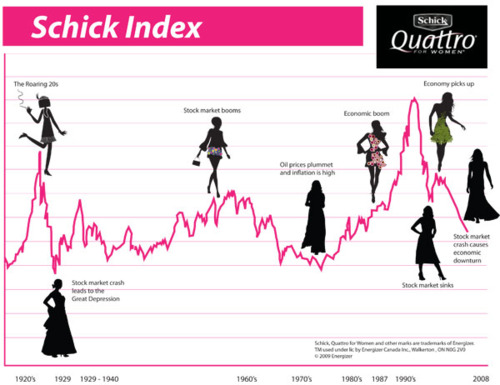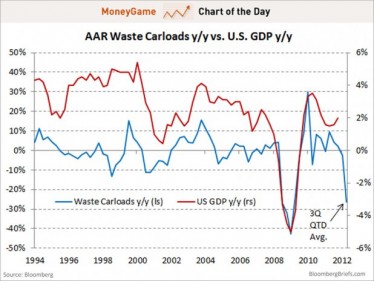Trash Talk

(The hemline index. I am suspicious, since Schick Quattro Razors have a vested interest in more skin. Image courtesy Schick Corporation.)
I know it is stupid to waste any time at all about the train-wreck that is coming in January. I mean, if no one else in town is taking the double-whammy of tax increases and sequestration of the Defense and Entitlement budgets seriously, why should we?
The fact that, should we be allowed to drift into the economic whirlpool, my industry, and by extension, me, will get whacked has an air of unreality. I imagine whoever wins the Olympian contest in November will do something about it. I certainly hope so.
But that brings the economy and its current ambivalence front and center into a discussion that one side would like to avoid, and the other wants to have front and center.
What is a citizen to do? Diving the entrails of a sacrificial animal is so fifteen hundred years ago. Isn’t there a better way to see the way ahead?
There are a host of indicators that are purported to tell the real tale of the consumer’s state of mind and mood, completely independent of the Bureau of Labor Statistics. You have heard about all of them. There was a time when I calculated daily incomes in the third world against the Big Mac standard, which is to say, the local currency converted into the number of two-all-beef-patties with special sauce on a sesame seed bun that a day’s labor was worth.
“Constant Burgernomics” I called it.
The comparative rate of burger prices were not particularly good for identifying domestic macroeconomics though. There is of course the correlation between the length of women’s skirts and macroeconomic activity. There is also the “lipstick index,” the “manicure index” and the “heel height index.”
The conventional wisdom is that women, who determine most major economic purchases, wear longer skirts, purchase lipstick, do their own nails and elevate their heels because of how they feel about the economy.
One argument about the success of the Indian economy during the period of the melt-down of the West (2008 and forward) is that Indian women do not wear skirts, but rather the unchanging ankle-length sari.
I naturally am incensed at the criteria. All these alleged indicators are not only sexist and demeaning, but also, to one degree or another, patently false.
Bogus as they might be, they are all based on the premise- accurate, I think- that no one has a clue as to what is going on, and it is easier to attribute our future to something irrelevant but familiar. No one has cared much about what any fashion-week designer put on the runway since Mary Quant sent the hems to the roof in the 1960s.
I did see one of those charts that does explain things in a non-traditional but arresting manner. It is the garbage index. It is pretty straightforward: the amount of trash we generate is a direct reflection of economic activity.
In this chart, the people at Business Insider lay out the amount of trash that is shipped by carload across the last decade. You can see what happened in 2008, when a world ended, though we did not know it at the time. You can see the correlation between carloads of waste and the GDP. So far, there is not a direct correlation between the GDP and amount of trash for the third quarter.
On the other hand, Trash data, being a private business, normally is available as much as six weeks ahead of unemployment data or tax receipts.

(The Trash Chart of the Day. Courtesy Business Insider).
Knowledgeable trash insiders say that as much as 30% of trash is composed of packaging, and a decline in the amount of finished good purchased could explain the decline. There are other factors, of course. Business and restaurant refuse could decline, based on fewer people shopping or dining out.
But it could also mean that a sudden and universal commitment to recycling has broken out. Considering the state of discourse on the political trail, I really am a bit surprised the trash man is not shipping a lot more.
I don’t know. It is certainly more fun looking at hemlines than trash, and it is entirely possible that nothing actually means anything. It could just be the usual trash-talk.
Copyright 2012 Vic Socotra
www.vicsocotra.com
